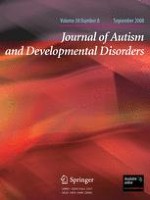01-09-2008 | Original Paper
One-year Change in Repetitive Behaviours in Young Children with Communication Disorders Including Autism
Gepubliceerd in: Journal of Autism and Developmental Disorders | Uitgave 8/2008
Log in om toegang te krijgenAbstract
Repetitive behaviours are a relatively neglected area of study in autism. Previous research has concluded that repetitive behaviour is inversely related to ability and that it tends to increase over the preschool years. One-hundred and four children ages 24–48 months, with autism, autism spectrum disorder (ASD) or other disorders, were followed for 13 months. Twelve items from the Autism Diagnostic Interview (ADI-R) were analysed, as well as diagnostic algorithm scores. Ability was related to degree of repetitive behaviours, except for one cluster of relatively able children. ADI-R repetitive behaviour algorithm scores increased over time; however, when all 12 behaviours were considered, there was a general decrease in impact upon the child’s and family’s activities. Reasons for this decrease are discussed.
